You are reading this article to know if terracotta pots are good for plants. Gardeners love terracotta pots, as many plants do well in them. You can use clay pots for indoor plants and gardening. But these are the things you need to know.
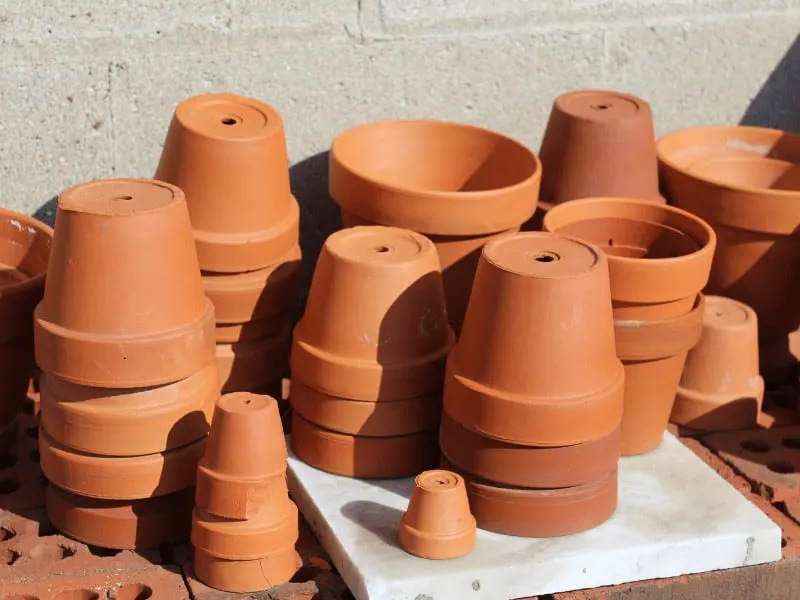
We get commissions for purchases made through links in this post.
Are Terracotta Pots Good For Plants?
Terracotta pots are great for plants as they allow for oxygen exchange due to their porous structure. In addition, they are soaking up excess moisture and are insulating plants from cold temperatures. Terracotta pots are affordable and can be recycled if broken.
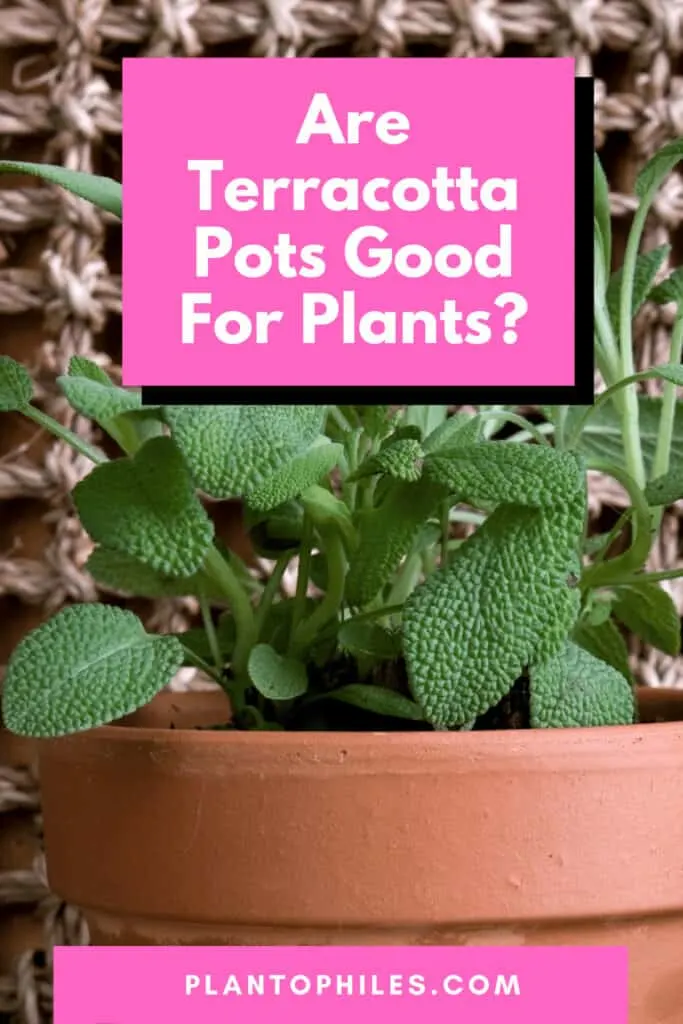
Terracotta pots can help prevent soil diseases as the porous walls allow air and water to move easily, which can be an advantage or disadvantage depending on the plant’s needs, according to Nebraska University.
They are an eco-friendly choice for gardening; they help control moisture.
Your choice of plant pot is essential because it will impact plant growth and maintenance.
Terracotta pots come in many sizes, shapes, styles, and designs.
This article has the information to help you decide whether terracotta suits your gardening or indoor plant needs.
Table of Contents
Terracotta Pots
The versatile, affordable, and reusable nature of terracotta clay pots makes them a favorite among gardeners.
Terracotta has many benefits for gardeners and flower growers; these baked clay pots are natural, porous, and have specific thermal properties.
Terracotta is an ancient material and a better planter choice if you tend to overwater your plants.
The porous nature of clay conditions the pot, which makes it difficult to overwater plants, and the roots can easily breathe.
Terracotta Pots
Terracotta pots reduce the risk of root rot and other overwatering diseases.
The color of the pot also indicates if the plant needs to be watered. The color is darker if moisture is present.
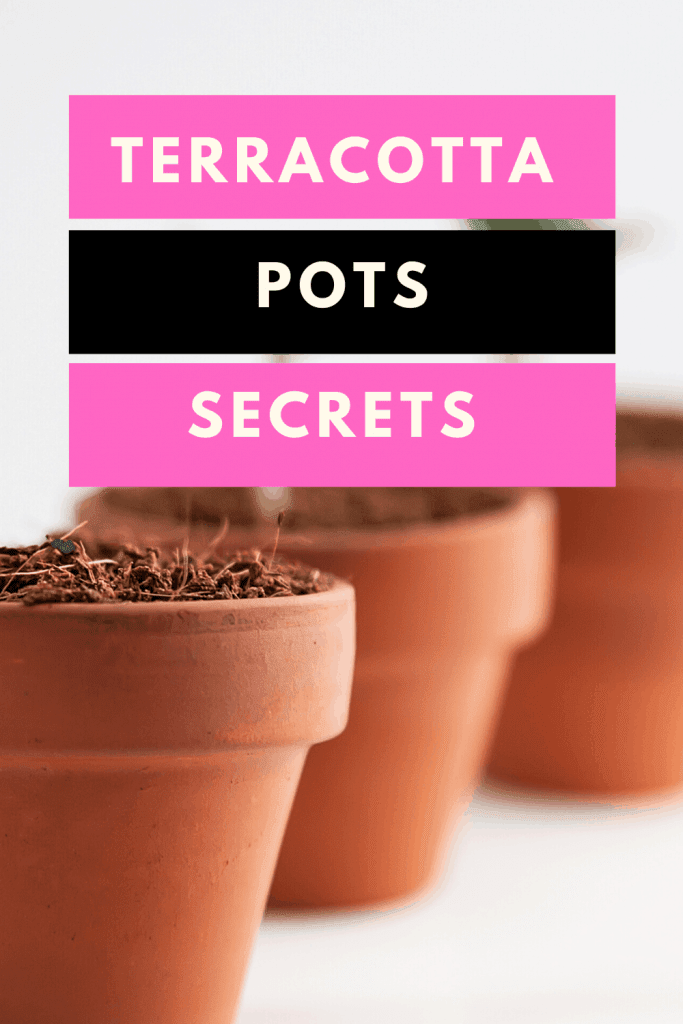
The unglazed pots allow for water and oxygen exchange, which improves soil aeration and protects your plant from staying wet for too long.
Most houseplants are better off too dry than too wet, and these pots are designed to keep the roots from sitting in standing water.
Excessive watering can damage plants since it clogs and blocks the roots from breathing, leading to root rot. The porosity of clay allows air and moisture to penetrate the sides of the pot.
The fine roots at the edge root system utilize this moisture and air.
Air movement stimulates root growth, which results in healthier plants. Terracotta pots absorb and release moisture, which naturally creates humidity for plants.
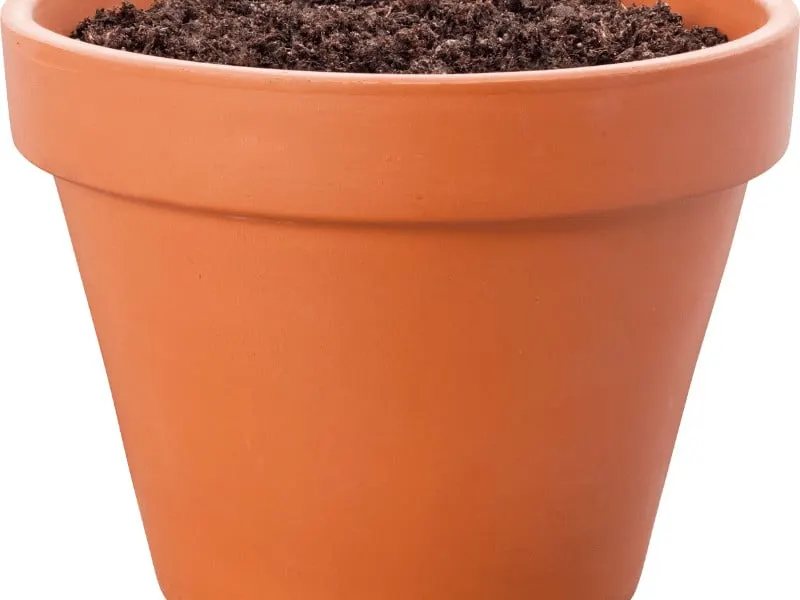
For this reason, plants that prefer dry soils thrive well in terracotta pots.
The terracotta pot’s rusty brown/orange color is compatible with almost any flower and foliage color.
The rusted look of the pot adds an organic touch and improves with age. Terracotta pots are effective in households with children or pets because they are heavier, thus, difficult to tip over.
Terracotta pots are more durable than plastic or any other type of pot.
These pots have saucers and drainage holes at the bottom to prevent soggy soil as water flows through the holes smoothly.
The drainage helps in preventing overwatering.
If you live in a colder region, you can use terracotta plants for your house plants.
The thick walls of the terracotta pot will drain the water quickly in case of low evaporation at the same time, insulating the plant from extreme temperature changes.
Where to Buy Terracotta Pots?
You can order terracotta pots online or from the local plant nursery. Check out our article about the best places to buy planters and pots online.
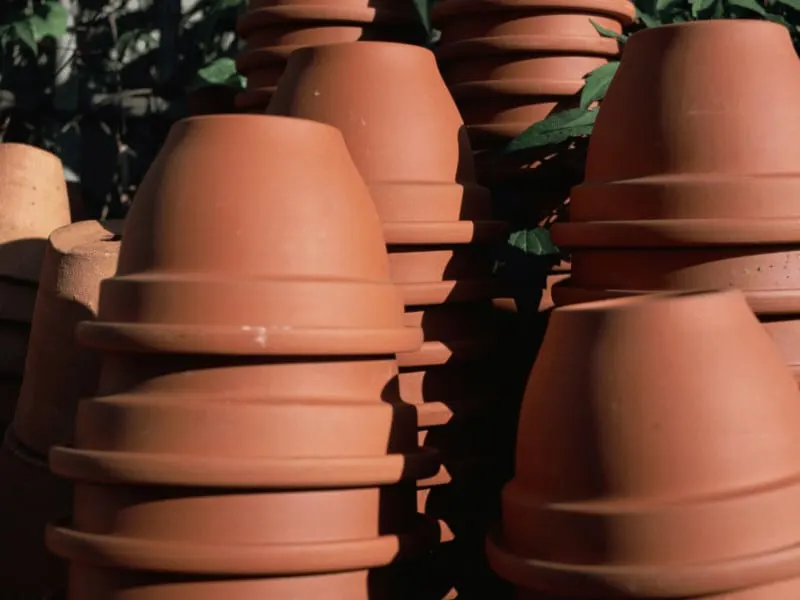
Benefits of Terracotta Pots
The most important benefits of terracotta pots are:
- Affordability
- Insulation
- Weight
- Recycling
Affordability: Terracotta pots are available in various shapes and sizes at affordable prices compared to other planters and containers.
You can even utilize used terracotta pots; you can buy old pots from recycling centers, thrift shops, or garage sales.
Simply clean and disinfect them. They are good to go.
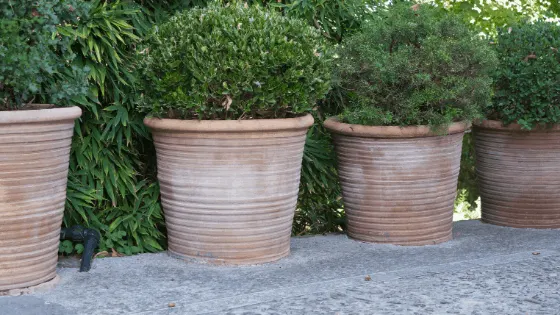
Insulation: A terracotta pot will slow the heat transfer between soil and the external environment to avoid a sudden temperature change.
Terracotta pots provide warmth during cold months and reduce heat during summer. Therefore they protect your plants throughout the year.
Terracotta pots are made of baked clay with excellent heat retention and repellent properties.
Weight: They are heavier than plastic pots but lighter and more comfortable moving than concrete or stone pots.
Their weight makes them useful for hardening off seedlings outdoors on windy sites where wind might overturn lightweight pots.
Recycling: The broken pot pieces can be reused as a filter to improve drainage, for edging, and as mulch. When you dispose of terracotta pots, you are not adding any harmful impact on the environment.
Terracotta Pots Disadvantages
The biggest disadvantages of Terrcotta pots are:
- Susceptibility to frost damage
- Dry out quickly
Terracotta is widely used for gardening. However, it isn’t necessarily the perfect living condition for all plants.
Since terracotta pots drain quickly, plants that require moist soil for growth may need to be watered more if planted in these pots.
You have to adjust your watering habits according to the pot’s nature and the plant’s water needs.
The biggest concern regarding terracotta pots is their susceptibility to frost damage.
Terracotta pots are vulnerable to changes in temperature and freezing snow.
The pot may break or crack due to the weather if you use terracotta for outdoor gardening in cold temperatures.
Try the following solutions to improve terracotta pot protection against frost damage:
Frost-resistant pots: The most practical solution is to buy a frost-resistant terracotta pot. The frost resistance of the pot is based on the type of clay used and the temperature at which the pots are fired.
Frost-resistant pots offer next-level protection as they are fired at a higher temperature. It makes them less porous as compared to regular terracotta pots.
Frostproof pots: They are designed to help terracotta pots survive frost. These pots are made by drying them naturally and then firing them to high temperatures.
It reduces the porosity to prevent water from soaking into the pot. This type of pot guarantees ten years of lifetime against frost damage.
Waterproofing: You can waterproof old and new pots to stop water penetration. You can spray or paint waterproofing products on pots to prevent frost damage.
Prepare a glue and water solution with a 10:1 water and PVA glue ratio.
Submerge the pot in the solution for 30 seconds. Now allow the pot to dry for 24 hours. The pot is sealed against water penetration.
Protective plant covers: Another feasible alternative to the chemical solution is wrapping.
You can wrap the plant and the pot with horticultural fleece or polythene bubble wrap.
A standard garden-grade fleece will protect to 27 degrees Fahrenheit (-3 degrees Celcius).
You can also use zip-up frost covers that protect the roots, foliage, and pot against frost damage.
Improve drainage: Frost damage for terracotta pots occurs when water soaks, freezes, and eventually causes cracks.
Improving the drainage to keep the pot as dry as possible will reduce the risk of cracks.
However, this can also cause the soil to dry out quickly, which means more watering.
Use well-drained potting compost for the winter months.
Add grit to the potting compost to improve drainage and keep the pot drier. Raise the base of terracotta pots from the ground using pot feet.
Doing this will help the pot drain freely.
If you will leave the terracotta pots outside all winter because plants are still growing in them, consider shifting them onto a concrete surface.
Rain can cause the pots to stick to the ground in freezing weather.
Dry out quickly: Terracotta pots dry out quickly because they are breathable due to their porous material. Some plants that like humid conditions can dry out too quickly. This is specifically true for tropical indoor plants.
How to Clean Terracotta Pots
Terracotta pots ensure better plant care and provide a healthy environment for plants.
But they need to be correctly cleaned and maintained for that.
Clean garden pots and containers indicate a healthy start for your precious plants.
I recommend cleaning and sterilizing the pots at the end of each season to reduce the threat of spreading fungus or mold that can infect new plants and damage the pots.
Terracotta pots do not need regular cleaning unless you notice some white residue or fungus growth.
You need to deep clean your terracotta pots to prevent fungus and algae growth.
The pores of the clay pot can retain the fungus and transfer them onto the plants.
I would suggest thoroughly cleaning old pots before replanting to avoid spreading disease or fungus.
The first step is to remove the plant carefully and let the residual soil dry before scraping it off.
Use a stiff cleaning brush to remove all of the dry dirt. Avoid using harsh chemicals to kill the fungus, as these chemicals may remain in the pores and get into plants when you replant.
You can use the methods below to disinfect and clean the terracotta pots properly.
Vinegar – Mix 1 part vinegar by volume with 3 parts water. You can use regular white vinegar or cleaning vinegar.
Cleaning vinegar has a higher percentage of acidity, which will help to break up the crusty buildup.
Soak the terracotta pots entirely in the white vinegar solution for 30 minutes.
Later use the pot brush to remove any residue that has been loosened up.
Bleach – Another approach follows the same procedure but uses bleach instead of white vinegar. But be careful, as bleach can damage the terracotta pots.
Use a ratio of 1:10 for bleach and water. Soak the pots in the mixture for 30 minutes. Soaking it in bleach will remove any fungus or dirt layers on the pot.
Now use a baking soda and water mixture to complete the cleaning process. Rub a paste using both and a toothbrush on the pot.
It will further remove any residue or dirt from the pot. Finally, rub the pot with dish soap and water to remove any remaining bacteria or chemicals.
Rinse thoroughly.
Whichever method you opt for deep cleaning, place the pots in the open air for a few days.
It allows the pot to dry completely and remove the leftover chemicals.
If you store the cleaned pots for future use, place them in a garage, shed, or any other area that stays dry and above freezing.
When you plant in terracotta pots, after some time, you will notice a white residue starts appearing on the terracotta pots.
It is because the terracotta pot begins to absorb the minerals in the soil.
The hard white crust also builds up from hard or salty water deposits.
This process causes discoloration on the pot surface.
The white residue is not toxic or harmful to plants, but you should remove it as it can serve as a host for fungus, pests, or diseases.
Spray the terracotta pot with hydrogen peroxide and remove the white crust with a toothbrush or fine steel wool. To prevent white residue, repeat the process occasionally.
You can also reduce watering and place the pot in direct sunlight.
How to Prepare Terracotta Pots for Planting
Preparing terracotta pots carefully before planting is crucial to minimize the risk of plant disease and create a healthy environment for your flowers, vegetables, and herbs.
Start by thoroughly cleaning the interior and exterior of the pot using white vinegar or bleach.
- If you are using an old pot, you can improve the look of the stained pot using linseed oil or a commercial sealer. Remove any residue or mineral deposits from the pot by scrubbing. Use a sponge or cloth rag to cover the pot’s exterior with oil.
- Fill up a sink and soak your terracotta pot in lukewarm water overnight or at least 30 minutes before potting your plant. These pots are made of clay, so soaking them beforehand will retain moisture and prevent the pot from taking up the plant water.
- Now position your pot on the pot feet, bricks, rocks, or pieces of wood to raise them off the ground. It will improve air circulation under the pot. It protects the pot from overheating and drying due to direct contact with cement or gravel surfaces.
- Fill the terracotta pot with potting soil within 1/2 inch of the edge. Deeply soak the soil using a water hose or water can prepare for planting. The top 1-2 inches of the soil should be moist.
Tips When Using Terracotta Pots
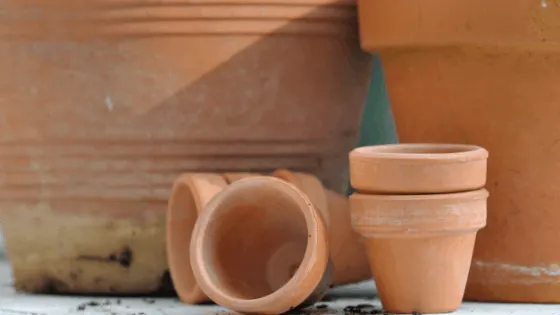
Terracotta pot care is quite easy and direct. Growing your favorite plants in them is an easy task.
Gardeners agree that it is difficult to overwater your houseplants in clay versus plastic or other pots.
I would recommend the following pro tips to enhance your gardening experience with terracotta pots:
- Use an organic fertilizer instead of a chemical fertilizer for your plants. Chemical fertilizer salts will accumulate in terracotta pots with time and cause white residue.
- Terracotta pots are quick-drying; mulch the soil to help retain water. You can use gravel, pine needles, wood chips, or cocoa hulls.
- If you plan to place the pots on wooden surfaces such as tables or dressers, use a plastic (or any other material) saucer instead of a clay saucer to protect the surfaces. A typical terracotta saucer is very porous, so water can leak through and ruin any wooden furniture. You can also use a glazed terracotta saucer so water doesn’t seep through.
- Usually, terracotta pots have drainage holes at the bottom. You can use coffee filters for pots with drainage holes. Pour the soil over the filter. Putting a filter will keep the soil in the pot but allow the water to drain easily.
- Be careful and gentle while moving your pots or handling them in cold weather, as they are vulnerable to cracks in such weather. Changes in the temperature, freezing, rain, or snow can lead to cracks as the clay expands and contracts.
- Instead of watering your plants with tap water, use rainwater. Tap water contains minerals and salts, which will clog the pores and cause a white residue.
- When you water your plants in terracotta pots, allow them to drain completely before placing them in the saucer or dish to avoid soggy soil.
- Terracotta pots are porous; they absorb moisture like a sponge. For plants that require wet soil conditions, you can customize the permeability of the pot by pre-treating the interior with a breathable latex sealant or adding a nonporous lining to the pot.
FAQ
How can I prevent cracks in terracotta pots?
The cracks on the pot cannot be repaired; you can prevent them by handling the pots with care while relocating or replanting. Do not overstuff the pot with soil as it will expand with watering and ensure the pot size is large enough for the root system of the plant you’re going to add.
What is the difference between terracotta and ceramic pots?
Ceramic pots may look like terracotta, but they are glazed with a coat of lacquer, which prevents the soil from drying out at the same rate as it would in a terracotta pot. Ceramic pots retain more moisture than the regular unglazed terracotta pots.
How can I remove the black mold on my terracotta pots?
Wash the pot and saucer with hot, soapy water to get rid of the mold. Frequently spray the pot with hydrogen peroxide to keep the mold from coming back. If the mold regrows despite the care, you may have to dispose of the pot.
Are terracotta pots safe for growing vegetables?
Terracotta pots are safe and suitable for vegetable gardening but thoroughly sterilize the pots before planting. Since terracotta is porous, it tends to absorb harmful chemicals or moisture. This way, it can contaminate the soil and present food safety issues.
Are terracotta pots better than plastic pots for outdoor planting?
Outdoor pots are mostly located in direct sunlight. Sunlight gradually degrades the plastic pots and makes them brittle unless you are using durable, thicker plastic pots. Terracotta is a better option for outdoor planting compared to plastic pots due to its insulation and heat retention properties.
What is the proper way to store terracotta pots?
You can store terracotta pots in a shed or garage for winterizing or simply reuse them in the future. The first step is to clean and dry the pots thoroughly. Now store them upside-down, avoid stacking them. Use newspaper or old towels between the pots to keep them from sticking.
What is winter cracking?
It is the most common reason for outdoor terracotta pot cracks. During the winter months, the water in the terracotta pot traps and freezes, which causes cracks. You can prevent this by ensuring proper drainage and moving the pot from the ground to a shelf or concrete surface. You may have to move the pots indoor.
Which plants do well in terracotta pots?
Succulents, Cacti, Mediterranean herbs, Moth Orchids, Snake plants, Aloe Vera, Monstera varieties, Syngonium varieties, Peperomia varieties are some of the plants that thrive well in terracotta pots.
Conclusion
Terracotta pots are the right choice for plants that prefer average to dry soil conditions.
Last update on 2025-01-16 / Affiliate links / Images from Amazon Product Advertising API


